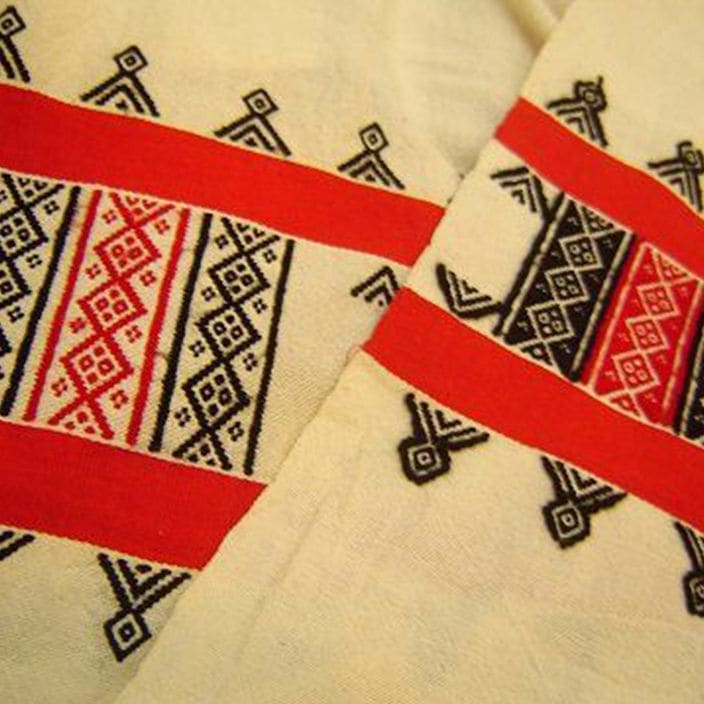For best prices and early deliveries, WhatsApp us at. 918488070070

Toda Embroidery
The art of embroidery is the oldest and the most diversely fascinating. No two regions of the world have the same kind of embroidery; they are all similar yet different in varying shapes, patterns and techniques. So, no wonder that in a vast country like India, the types of embroideries are countless and distinct. In Tamil Nadu, the “Toda” embroidery plays a significant role in the region’s culture and history. Locally known as “pukhoor”, which means flower, this embroidery is specifically created by women of the Toda tribe, belonging to the Nilgiri Hills. Similar to other tribal art forms, Toda tribal embroidery is also inspired by nature and its small, beautiful elements. What is truly fascinating about this embroidery is that the handwork is so fine that one might mistake it for being *entwined with the yarns of the fabric itself or just tightly woven with the help of machines.
Tracing Its Origin
Toda embroidery derives its name from the tribe which gave birth to it – the Toda or, Tudas. This tribe is originally Dravidians, who have migrated to various places around the world, and a majority of them have settled in the state of Tamil Nadu, making the region of Nilgiri Hills their home. A discovery by the Indian Institute of Science has stated that the Todas have been staying in the Nilgiris for almost 3,500 years. This pastoral tribe has thus, given Tamil Nadu pride in a unique art form; the embroidery acquired the Geographical Indication tag in 2013.
The women of the Toda community are oppressed, they live life with strict principles and follow age-old traditions. Their Toda embroidery has been one such tradition that has been an ancient practise amongst the women, who use red and black threads to embroider beautiful patterns that are influenced by aspects of nature and tribal folk tales. These embroideries were conventionally made on cloaks called “pootkhuly” wrapped by the Toda men and women.
How They’re Made
What makes this embroidery unusual from the others is its sewing pattern. It is unlike any other mainstream embroideries where the thread is simply sewn on the fabric, using a frame to make desired patterns. Here the warp and weft yarns of the base fabric are closely counted and done with the help of the reverse-stitch method. The patterns are embroidered so closely, following the thread count, that they look like they have been machine woven with no rough edges at the back as well. No sewing frame of any sort is used, and yet, the accuracy and intricacy of women who have no technical knowledge is mind-blowing.
This kind of embroidery is mainly done on coarse cotton fabric, traditionally white, beige or cream. Black and red threads are used to make the motifs, the most common of which is a flower. Nature plays a vital role in this art form, as the tribe solely lives in the lap of nature.
Design Element
The kind of excellent craftsmanship that these women do, without any professional training or even modern learning, is a gift of ancient traditions that have been handed down to generations. Every motif in the pattern has a meaning that is close to life and nature.
Apart from the common flower, some motifs that are used include zigzag lines called “Hutz”. Booth Puhur is a combination of hearts and dots done on the border, whereas “Esh Puhur” is the name for arrow shapes designs, which are vital in tribal livelihood for hunting. Geometric shapes are vastly seen in this art form, including diamonds, triangles and hearts. A signature “W” design is made on the shawls covering the body of the fabric, known as “Thur Puhur”.
Toda Embroidery Today
With the help of the G. I. tag given by the government of India, the Toda embroidery has come a long way in its path to recognition. It is, without a doubt, one of the most ancient and rare art forms to exist, which makes it all the more fascinating. As people have come to discover it, the craft can be seen in modern designs like bags and jackets exported outside of Tamil Nadu. With the help of recent “slow fashion” movements, the art has reached platforms that will help more designers notice it.
Toda embroidery is a traditional craft practiced by the Toda community in Tamil Nadu, India, which involves intricate stitching of geometric designs using colorful threads on white or cream-colored kanchi cotton fabric, and is often embellished with chinkankari, a delicate and ornate style of embroidery.
Image Credits
Medium | Nift | Rural India | Stades | The Little Things | Copy of Austria | Behance | Sadhguru Encyclopedia | Auchitya